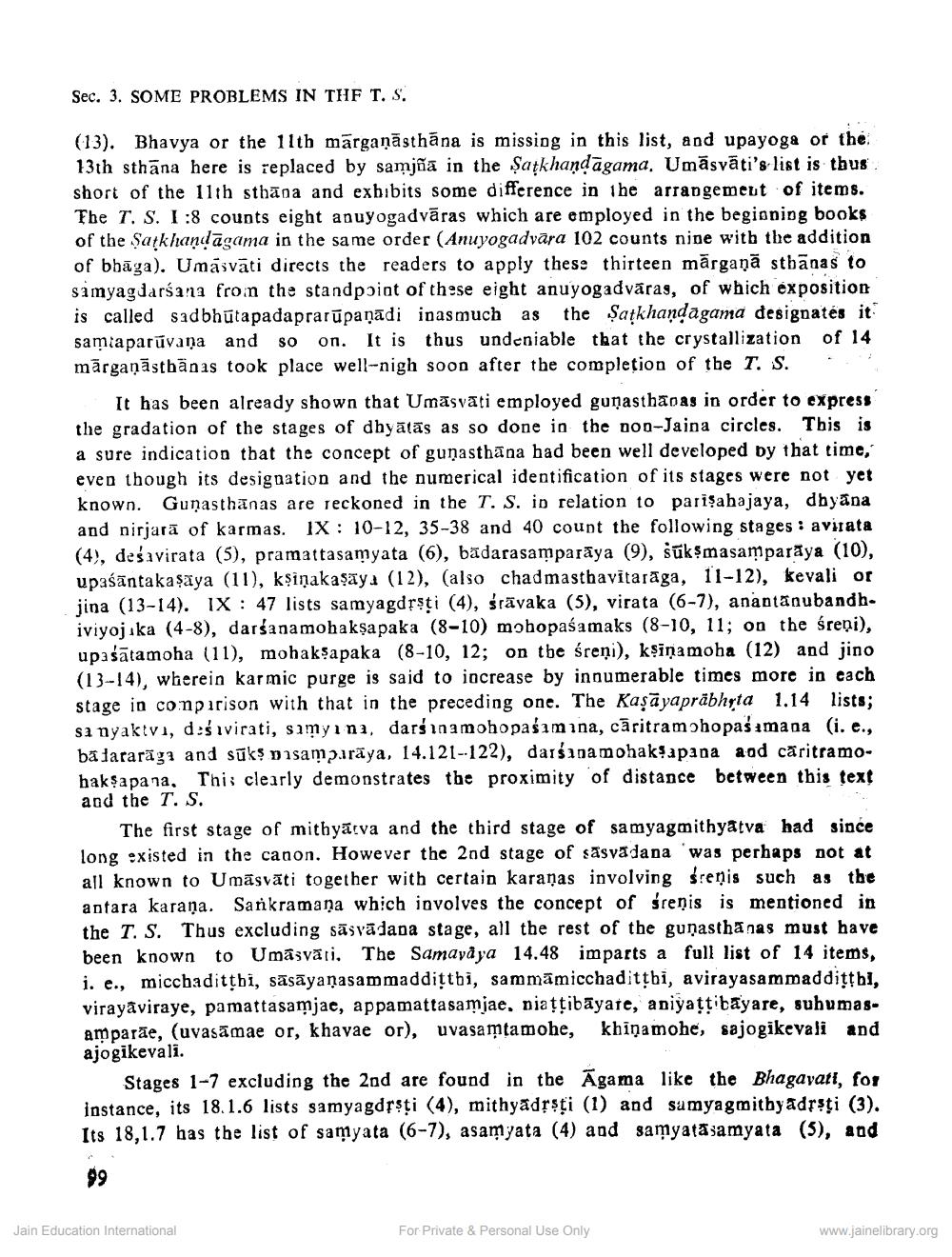________________
Sec. 3. SOME PROBLEMS IN THF T. S.
(13). Bhavya or the 11th marganästhāna is missing in this list, and upayoga or the 13th sthana here is replaced by samja in the Satkhandagama. Umāsväti's list is thus. short of the 11th sthana and exhibits some difference in the arrangement of items. The 7. S. 1:8 counts eight anuyogadvāras which are employed in the beginning books of the Sarkhandagama in the same order (Anuyogadvara 102 counts nine with the addition of bhaga). Umásväti directs the readers to apply these thirteen märgană sthānas to samyagdarśana from the standpoint of these eight anuyogadvaras, of which exposition is called sadbhütapadaprarüpapadi inasmuch the Satkhandagama designates it samtaparuvana and so on. It is thus undeniable that the crystallization of 14 märganästhānas took place well-nigh soon after the completion of the T. S.
It has been already shown that Umasvati employed gunasthanas in order to express the gradation of the stages of dhyatas as so done in the non-Jaina circles. This is a sure indication that the concept of gunasthana had been well developed by that time," even though its designation and the numerical identification of its stages were not yet known. Gunasthanas are reckoned in the T. S. in relation to paritahajaya, dhyana and nirjara of karmas. IX: 10-12, 35-38 and 40 count the following stages: avirata (4), deśavirata (5), pramattasamyata (6), badarasamparaуa (9), sükṣmasamparaya (10), upasantakasaya (11), kṣinakasaya (12), (also chadmasthavitaraga, 11-12), kevali or jina (13-14). IX 47 lists samyagdrati (4), śrävaka (5), virata (6-7), anant nubandhiviyojka (4-8), darśanamohakṣapaka (8-10) mohopaśamaks (8-10, 11; on the śrepi), upasātamoha (11), mohakṣapaka (8-10, 12; on the śreni), ksinamoha (12) and jino (13-14), wherein karmic purge is said to increase by innumerable times more in each. stage in comparison with that in the preceding one. The Kaşayaprabheta 1.14 lists; sa nyaktva, disavirati, samyana, dariinamohopaśimina, caritramohopašamana (i. e., bafararags and suks misamparaya. 14.121-122), darsina mohaktapana and caritramohakṣapana. This clearly demonstrates the proximity of distance between this text and the T. S.
The first stage of mithyärva and the third stage of samyagmithyatva had since long existed in the canon. However the 2nd stage of sasvadana was perhaps not at all known to Umäsväti together with certain karanas involving śreņis such as the antara karana. Sankramana which involves the concept of irenis is mentioned in the T. S. Thus excluding sasvadana stage, all the rest of the gunasthanas must have been known to Umasvati. The Samayaya 14.48 imparts a full list of 14 items, i. e., micchaditṭhi, sasayaṇasammaddiṭthi, sammamiechadittbi, avirayasammadditthl, virayaviraye, pamattasamjae, appamattasamjae, niaṭṭibayare, aniyaṭṭibayare, suhumasamparãe, (uvasamae or, khavae or), uvasamtamohe, khiņamohe, sajogikevali and ajogikevali.
Stages 1-7 excluding the 2nd are found in the Agama like the Bhagavatt, for instance, its 18.1.6 lists samyagdṛṣṭi (4), mithyadrști (1) and samyagmithy adṛṣṭi (3). Its 18,1.7 has the list of samyata (6-7), asamyata (4) and samyatasamyata (5), and
99
Jain Education International
For Private & Personal Use Only
www.jainelibrary.org




